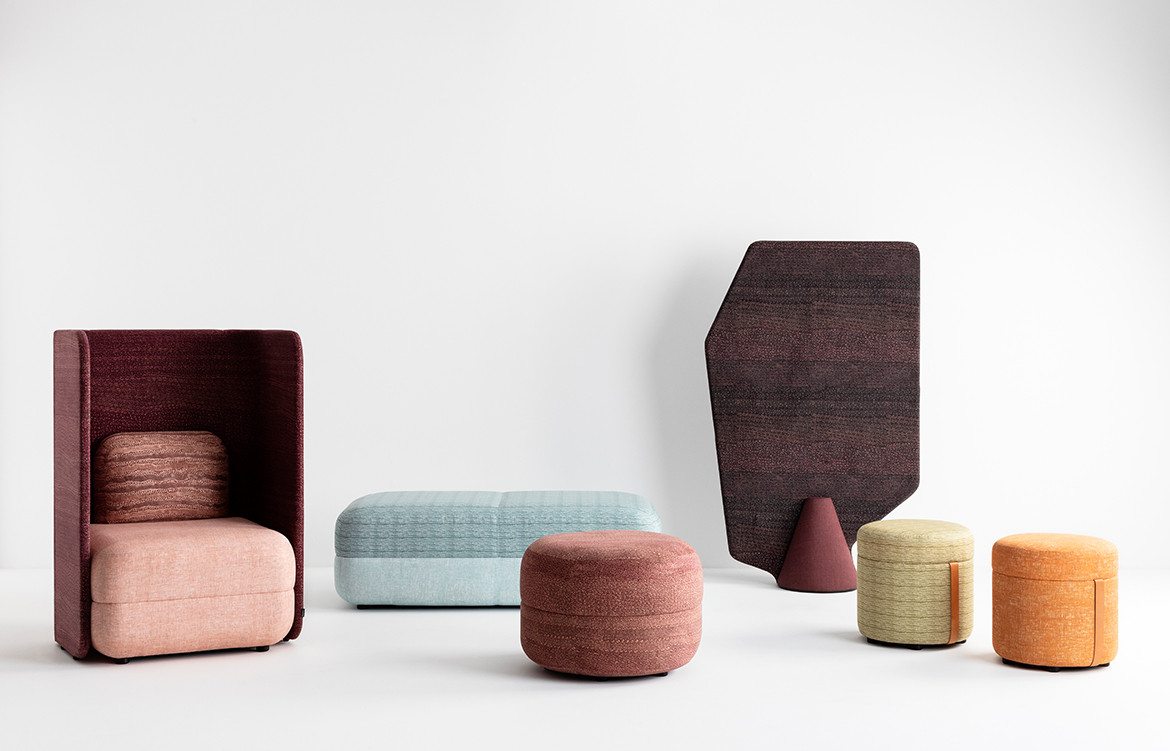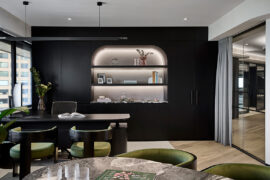In celebrating the rich visual storytelling of Indigenous artists through a carefully curated selection of captivating designs for textiles and wallpapers, Willie Weston brings the artistry of First Nations people into commercial and residential interiors across the country.

With a profound commitment to celebrating artistic expression, recognising the unquestionable importance of Indigenous narratives and fostering meaningful relationships at the heart of Willie Weston’s ethos, it comes as no surprise that these elements sit at the core of the brand’s origin story.
Brought together by a passion for the arts, Willie Weston’s non-Indigenous co-founders – Jessica Booth and Laetitia Prunetti – met at university while completing masters degrees in art curatorship. After graduation, the women parted ways – Jessica to further pursue her specialisation in Indigenous art; Laetitia to immerse herself in the world of arts organisations such as Heide Museum of Modern Art and the Melbourne Art Fair.
But despite their careers taking them down divergent paths, their friendship continued, as did their shared passion for maintaining a highly ethical work practice and their deep commitment to helping facilitate commercial opportunities for artists. That’s how Willie Weston came to be.

Willie Weston’s Durrmu Collection featuring designs by Leanne Black, Kathleen Korda and Annunciata Nunuk Wilson on pieces from the Precinct Collection by Zenith. Photo: Martina Gemmola
The Melbourne-based company was born out of the desire to celebrate the rich artistic legacy of Australia’s First Peoples and to integrate their designs into built environments nationally and internationally. Bringing this ambition to life, Jessica and Laetitia collaborate with a group of contemporary Indigenous artists to develop unique, contemporary and high-performing textiles and wallpapers designed for residential, commercial, hospitality, healthcare, and outdoor settings.
Through their partnership with Willie Weston, the Indigenous artists involved are paid for each metre produced, providing ongoing income streams outside their primary art practices. The creators also receive a share of Willie Weston’s net profits at the end of each financial year, which equated to 30% of their net profits in this past financial year. “Willie Weston exists to provide meaningful income for artists,” says Laetitia Prunetti, expressing the company’s aim of contributing to improved livelihoods in Indigenous communities throughout the country. “As we grow, we are committed to building on the financial returns made to the artists we’re so lucky to work with”.

Willie Weston’s Durrmu Collection featuring designs by Leanne Black, Kathleen Korda and Annunciata Nunuk Wilson on pieces from the Precinct Collection by Zenith. Photo: Martina Gemmola
Since its inception in 2015, Willie Weston has partnered with five Indigenous-owned art centres across the Northern Territory and Western Australia, showcasing the unparalleled breadth of unique Indigenous narratives and styles of visual expression.
The Fitzroy Crossing Collection was developed with Marnin Studio and three artists from the Fitzroy Valley, located in the heart of Kimberley. The incredible designs of the Indigenous craftswomen, Amanda Smith, Lee-Anne Williams and April Jones, are all firmly anchored in the magnificent landscape of North-Western Australia.

Fabrics from the Fitzroy Crossing Collection: Water Levels in ‘Moss’ [left screen], ‘Flint’ [ottoman] and ‘Tide’ [box], and Rainbows in ‘Marul’ [right screen] and ‘Pindan’ [low ottoman]. Photo: Caitlin Mills Photography.

Willie Weston’s Wak Wak design in ‘Mud Flats’ by Susan Marawarr [workstations] and Mud Ripples design in ‘Wild Red Apple’ by Elizabeth Kandabuma [Wes Armchairs]. Photo: Hadyn Cattach.

The JAC chair by Zenith Interiors featuring Native Seeds in ‘Midnight’ by Jean Ngwarraye Long. Photo: Pablo Martin.
Much like their earlier collaborations, Willie Weston’s latest collection of textiles is a respectful and considered celebration of Indigenous design. The rich, earthy and sophisticated palette of the Durrmu Collection is an apt reflection of the vibrant culture of the region and has been developed in partnership with Indigenous-owned art centre, Durrmu Arts, located in Peppimenarti in Northern Territory. The collection features intricate designs from three artists – Leanne Black, Kathleen Korda and Annunciata Nunuk Wilson.
Leanne Black is an emerging artist from Peppimenarti who works predominantly in screen printing. Like many artists from this area, Leanne references durrmu (the body painting dot) in her work, including her design contribution to the Durrmu Collection – “Durrmu (LB)”. Kathleen Korda was born at the Daly River Mission and moved to Peppimenarti as a teenager. The artist learnt to weave baskets, string bags and fishnets from the women in her family. Today, Kathleen is establishing herself as a leading weaver at Durrmu Arts. Kathleen’s intricate design for this collection is called “Durrmu (KK)”, from which Willie Weston have developed a rich palette ranging from the earthy “Terra”, deep “Berry”, and high contrast “Obsidian” to a more subtle “Bush Banana”.

Willie Weston’s Durrmu Collection featuring designs by Leanne Black, Kathleen Korda and Annunciata Nunuk Wilson on pieces from the Precinct Collection by Zenith. Photo: Martina Gemmola
Annunciata Nunuk Wilson is a Ngan’gikurunggurr woman and the eldest daughter of the renowned artist Regina Pilawuk Wilson. Annunciata often paints durrmu designs in the traditional colours of weaving dyes: deep purples, ochres, black and reds. Her design is called “Syaw” – which translates to “Fish Net” – and evokes nets traditionally woven with bush vine by the people of the region to capture fish and crayfish from the local creeks and rivers.
“This collection highlights once again the breadth of artistic talent in remote Australia,” says Jessica Booth. “We are extremely fortunate to have been entrusted with these artworks, and we are excited to introduce them to the architecture and design sector.” With their fabrics stocked nationally by Zenith and a new collaboration with outdoor furniture brand, Tait, just released, Willie Weston is forging new ground for the inclusion of Indigenous design in our interior and exterior environments.
INDESIGN is on instagram
Follow @indesignlive
A searchable and comprehensive guide for specifying leading products and their suppliers
Keep up to date with the latest and greatest from our industry BFF's!

How can design empower the individual in a workplace transforming from a place to an activity? Here, Design Director Joel Sampson reveals how prioritising human needs – including agency, privacy, pause and connection – and leveraging responsive spatial solutions like the Herman Miller Bay Work Pod is key to crafting engaging and radically inclusive hybrid environments.

A curated exhibition in Frederiksstaden captures the spirit of Australian design

Gaggenau’s understated appliance fuses a carefully calibrated aesthetic of deliberate subtraction with an intuitive dynamism of culinary fluidity, unveiling a delightfully unrestricted spectrum of high-performing creativity.

Intricate motifs imbued with Culture create stunning patterns in Willie Weston’s newest collection – sharing lost stories of Country from Gadigal artist Kate Constantine.

An exciting new collaboration involving Autex Acoustics, Willie Weston and Lisa Waup colourfully brings First Nations design to high-performance acoustics.
The internet never sleeps! Here's the stuff you might have missed

Setting the tone for McCormack’s HQ is Elton Group’s Eveneer WoodWall and Eveneer Raw in Ravenna – wrapping walls, ceilings and bespoke joinery in a dark, matte elegance. The seamless pairing delivers a cohesive, high-performance finish that anchors Studio 103’s luxurious, hotel-inspired workplace design.

For three-quarters of a century, the iconic Eames Shell Chair has redefined the very act of sitting with its groundbreaking form, proving that, rather than restrict, the right mould can embrace every space, need and individual aspiration.